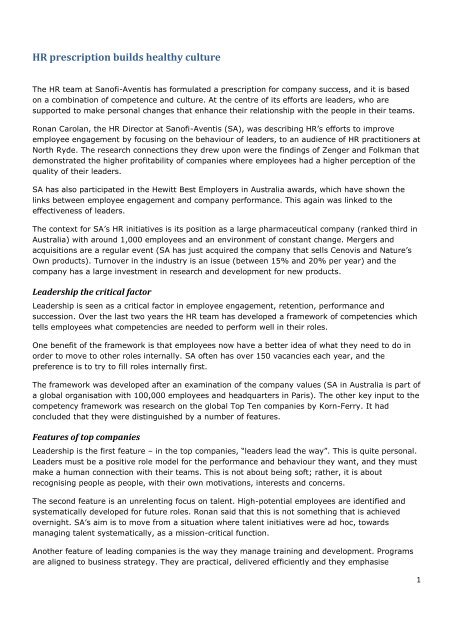Sanofi Aventis - Glennmartin.com.au
Sanofi Aventis - Glennmartin.com.au
Sanofi Aventis - Glennmartin.com.au
Create successful ePaper yourself
Turn your PDF publications into a flip-book with our unique Google optimized e-Paper software.
HR prescription builds healthy culture<br />
The HR team at <strong>Sanofi</strong>-<strong>Aventis</strong> has formulated a prescription for <strong>com</strong>pany success, and it is based<br />
on a <strong>com</strong>bination of <strong>com</strong>petence and culture. At the centre of its efforts are leaders, who are<br />
supported to make personal changes that enhance their relationship with the people in their teams.<br />
Ronan Carolan, the HR Director at <strong>Sanofi</strong>-<strong>Aventis</strong> (SA), was describing HR’s efforts to improve<br />
employee engagement by focusing on the behaviour of leaders, to an <strong>au</strong>dience of HR practitioners at<br />
North Ryde. The research connections they drew upon were the findings of Zenger and Folkman that<br />
demonstrated the higher profitability of <strong>com</strong>panies where employees had a higher perception of the<br />
quality of their leaders.<br />
SA has also participated in the Hewitt Best Employers in Australia awards, which have shown the<br />
links between employee engagement and <strong>com</strong>pany performance. This again was linked to the<br />
effectiveness of leaders.<br />
The context for SA’s HR initiatives is its position as a large pharmaceutical <strong>com</strong>pany (ranked third in<br />
Australia) with around 1,000 employees and an environment of constant change. Mergers and<br />
acquisitions are a regular event (SA has just acquired the <strong>com</strong>pany that sells Cenovis and Nature’s<br />
Own products). Turnover in the industry is an issue (between 15% and 20% per year) and the<br />
<strong>com</strong>pany has a large investment in research and development for new products.<br />
Leadership the critical factor<br />
Leadership is seen as a critical factor in employee engagement, retention, performance and<br />
succession. Over the last two years the HR team has developed a framework of <strong>com</strong>petencies which<br />
tells employees what <strong>com</strong>petencies are needed to perform well in their roles.<br />
One benefit of the framework is that employees now have a better idea of what they need to do in<br />
order to move to other roles internally. SA often has over 150 vacancies each year, and the<br />
preference is to try to fill roles internally first.<br />
The framework was developed after an examination of the <strong>com</strong>pany values (SA in Australia is part of<br />
a global organisation with 100,000 employees and headquarters in Paris). The other key input to the<br />
<strong>com</strong>petency framework was research on the global Top Ten <strong>com</strong>panies by Korn-Ferry. It had<br />
concluded that they were distinguished by a number of features.<br />
Features of top <strong>com</strong>panies<br />
Leadership is the first feature – in the top <strong>com</strong>panies, “leaders lead the way”. This is quite personal.<br />
Leaders must be a positive role model for the performance and behaviour they want, and they must<br />
make a human connection with their teams. This is not about being soft; rather, it is about<br />
recognising people as people, with their own motivations, interests and concerns.<br />
The second feature is an unrelenting focus on talent. High-potential employees are identified and<br />
systematically developed for future roles. Ronan said that this is not something that is achieved<br />
overnight. SA’s aim is to move from a situation where talent initiatives were ad hoc, towards<br />
managing talent systematically, as a mission-critical function.<br />
Another feature of leading <strong>com</strong>panies is the way they manage training and development. Programs<br />
are aligned to business strategy. They are practical, delivered efficiently and they emphasise<br />
1
leadership development. Courses are not conducted just for the sake of doing “something” to fulfil<br />
your annual personal development plan.<br />
Leadership <strong>com</strong>petencies<br />
The <strong>com</strong>petencies of leadership were a key part of the <strong>com</strong>petency framework. The HR team sees it<br />
as important to base them on the <strong>com</strong>pany values and the business strategy, and to identify specific<br />
leadership behaviours, but they also wanted to avoid having an overload of concepts. They arrived<br />
at seven leadership behaviours that align with the <strong>com</strong>pany values. The behaviours are: courage,<br />
<strong>au</strong>dacity, performance, solidarity, respect and creativity.<br />
A number of priorities for HR ensued from the framework. Job profiles were re-examined, so that it<br />
was clear what <strong>com</strong>petencies were required. The approach taken was: what does success look like in<br />
this job? What does it look like when you do the job well? A <strong>com</strong>petency dictionary was produced to<br />
make meanings clear to employees. A set of 21 leadership <strong>com</strong>petencies was devised, and this is<br />
the palette from which the <strong>com</strong>petencies for particular positions are drawn.<br />
Talent management<br />
Talent management is another priority. A distinction is made between current performance and<br />
future potential. Research by the Corporate Leadership Council has found that only around 30% of<br />
current high performers are high-potentials. This is often related to a person being a good technical<br />
performer but not really suited to a leadership role.<br />
The indicators of potential that are used to assess employees are: adaptability, ability to apply<br />
learning, productive relationship-building, initiative, tenacity, judgement and ability to plan and<br />
organise. Employees are determined as low, medium or high-potential, and opportunities for<br />
development and experience are mostly focused on the high-potentials.<br />
Culture underpins <strong>com</strong>petency<br />
The <strong>com</strong>plementary aspect of the work on <strong>com</strong>petency is corporate culture. Culture is seen as the<br />
key to both engagement and performance, and leaders are seen as the drivers of culture. Hence the<br />
focus has shifted to culture, and this is seen as building around the values of the <strong>com</strong>pany, through<br />
the behaviour of leaders.<br />
Employee surveys are undertaken at periodic intervals. The results are <strong>com</strong>municated back to<br />
employees, warts and all. Ronan is emphatic that it is better not to ask employees what they think if<br />
you are not willing to be open about the findings. Surveys also require a response from leaders, and<br />
it might mean them taking on personal change in order to make relationships more constructive.<br />
Many of the leadership team are currently working with coaches on specific issues they are trying to<br />
address. The most recent employee survey showed a 20% increase in engagement over the<br />
previous survey. This is encouraging, and indicates that progress can be made in the area of<br />
personal behaviour. The longer-term out<strong>com</strong>e is improved overall <strong>com</strong>pany performance.<br />
© 2008 Glenn Martin<br />
glennpmartin@optusnet.<strong>com</strong>.<strong>au</strong><br />
2



